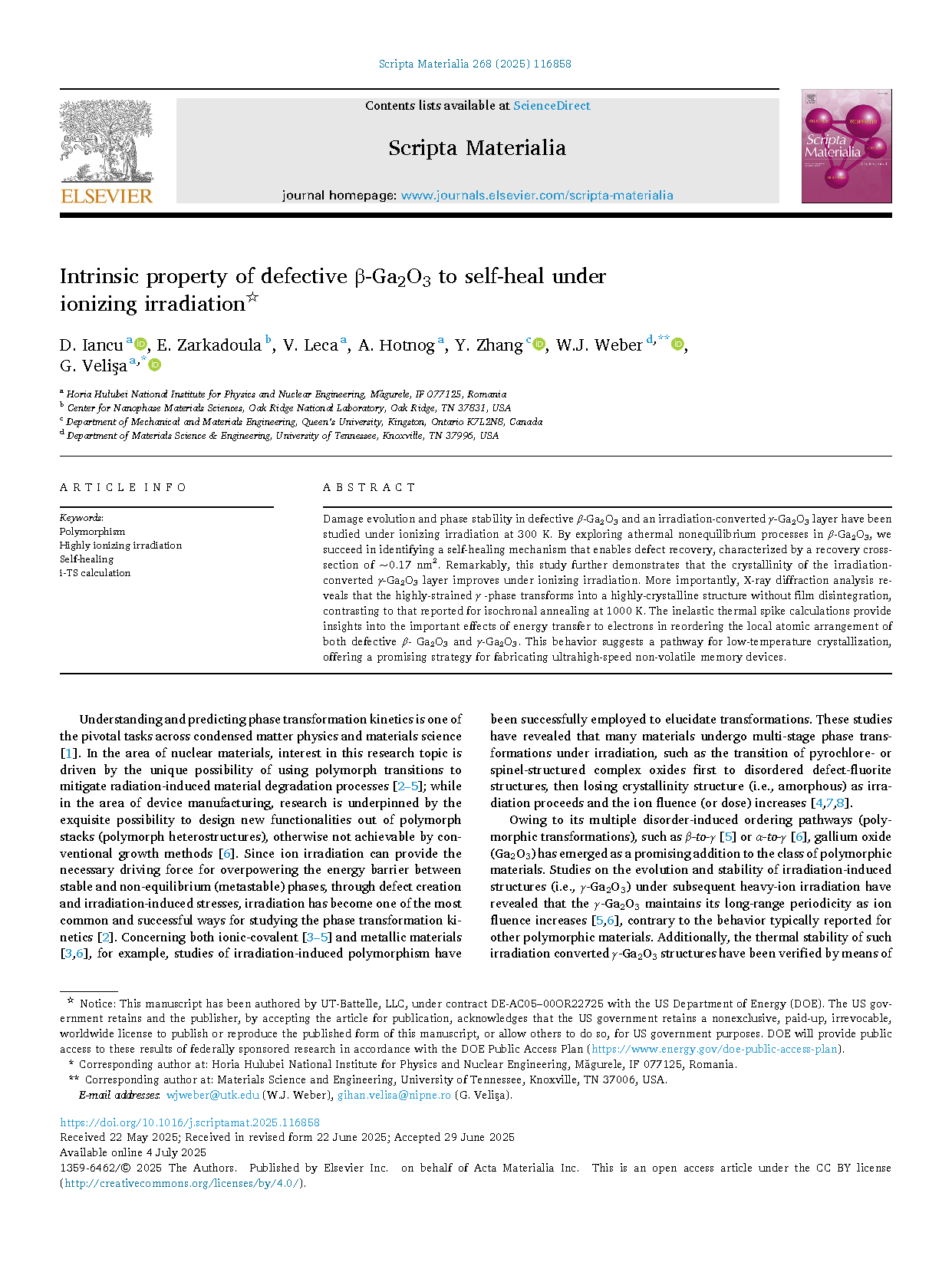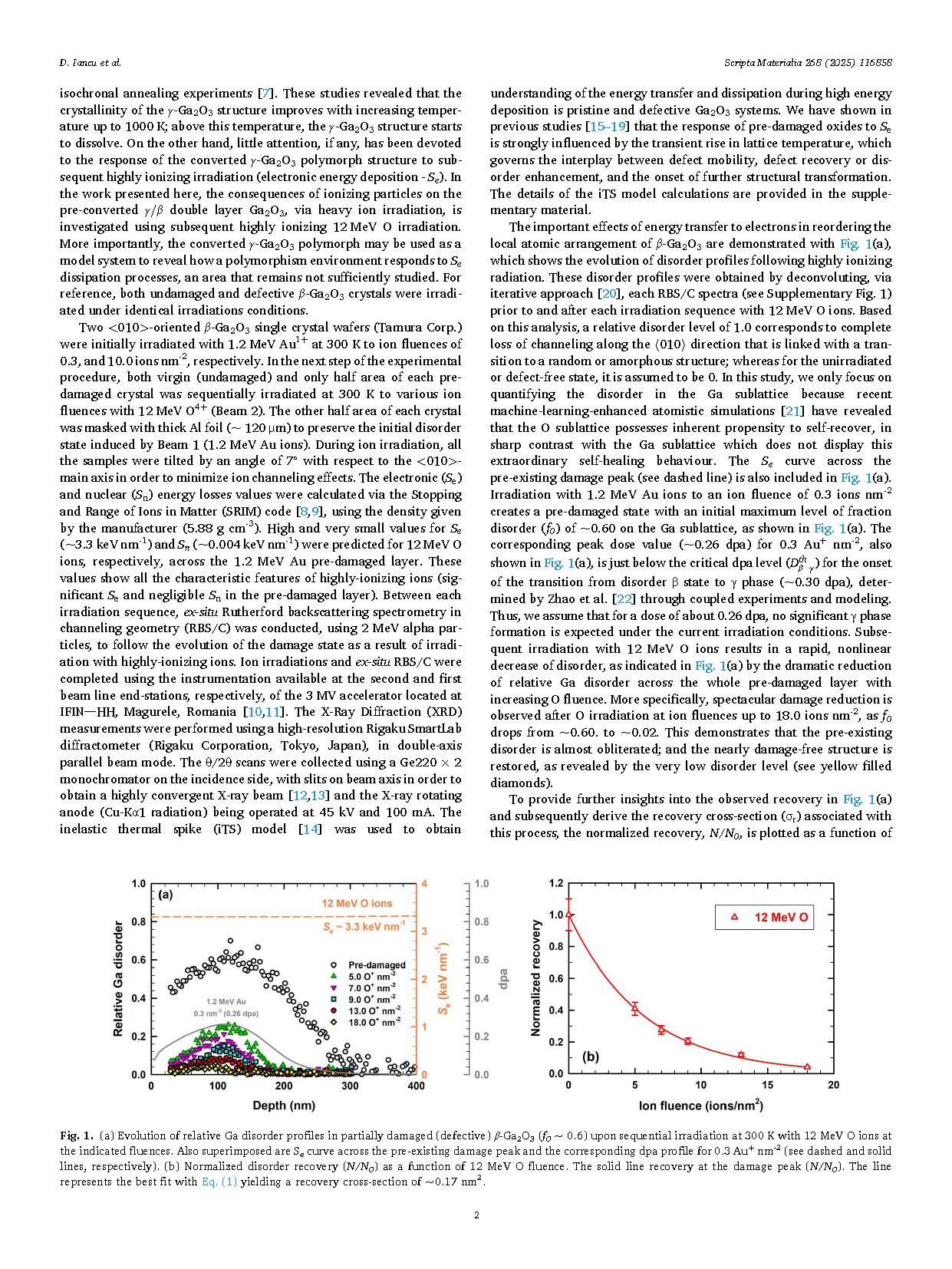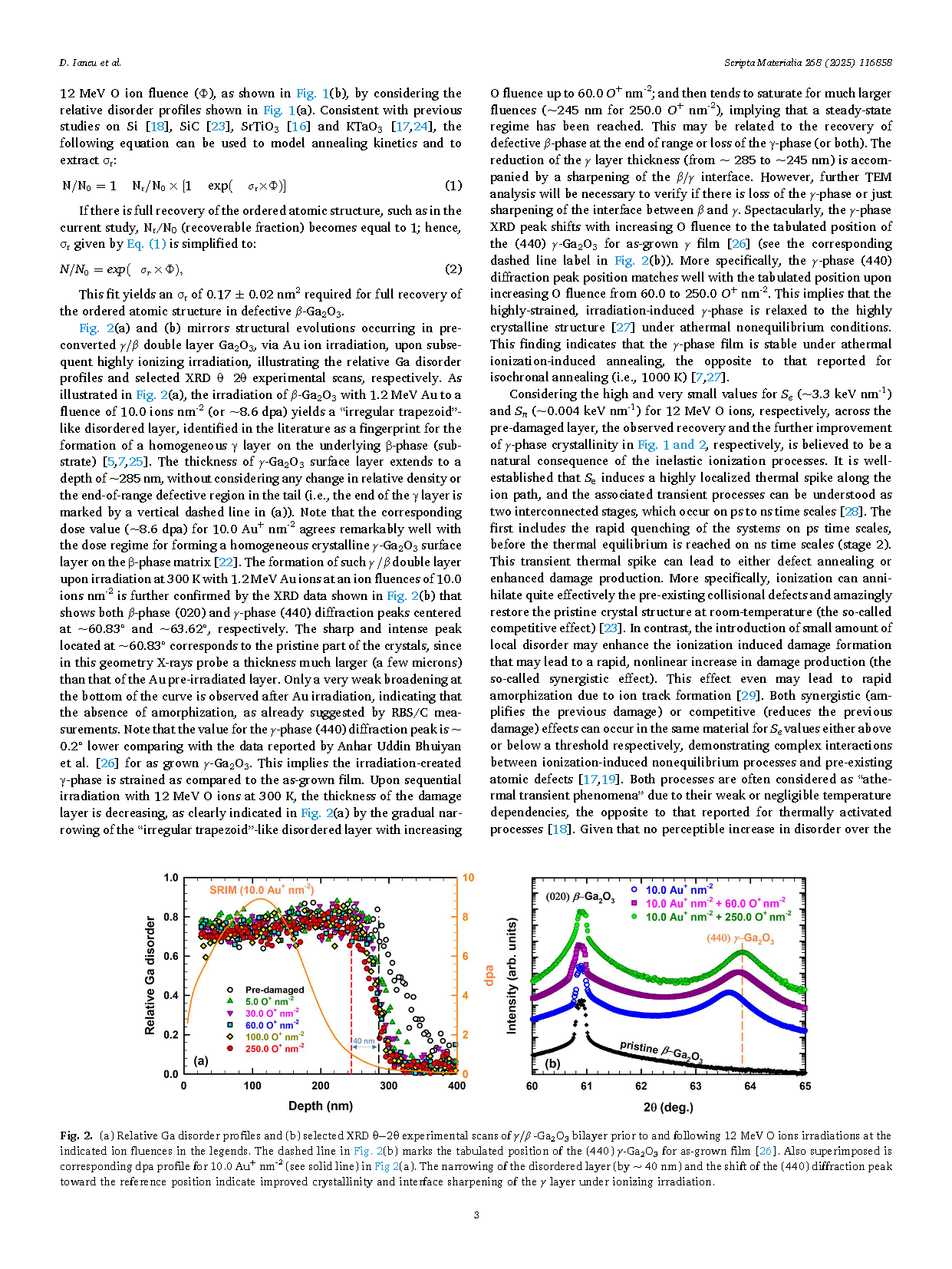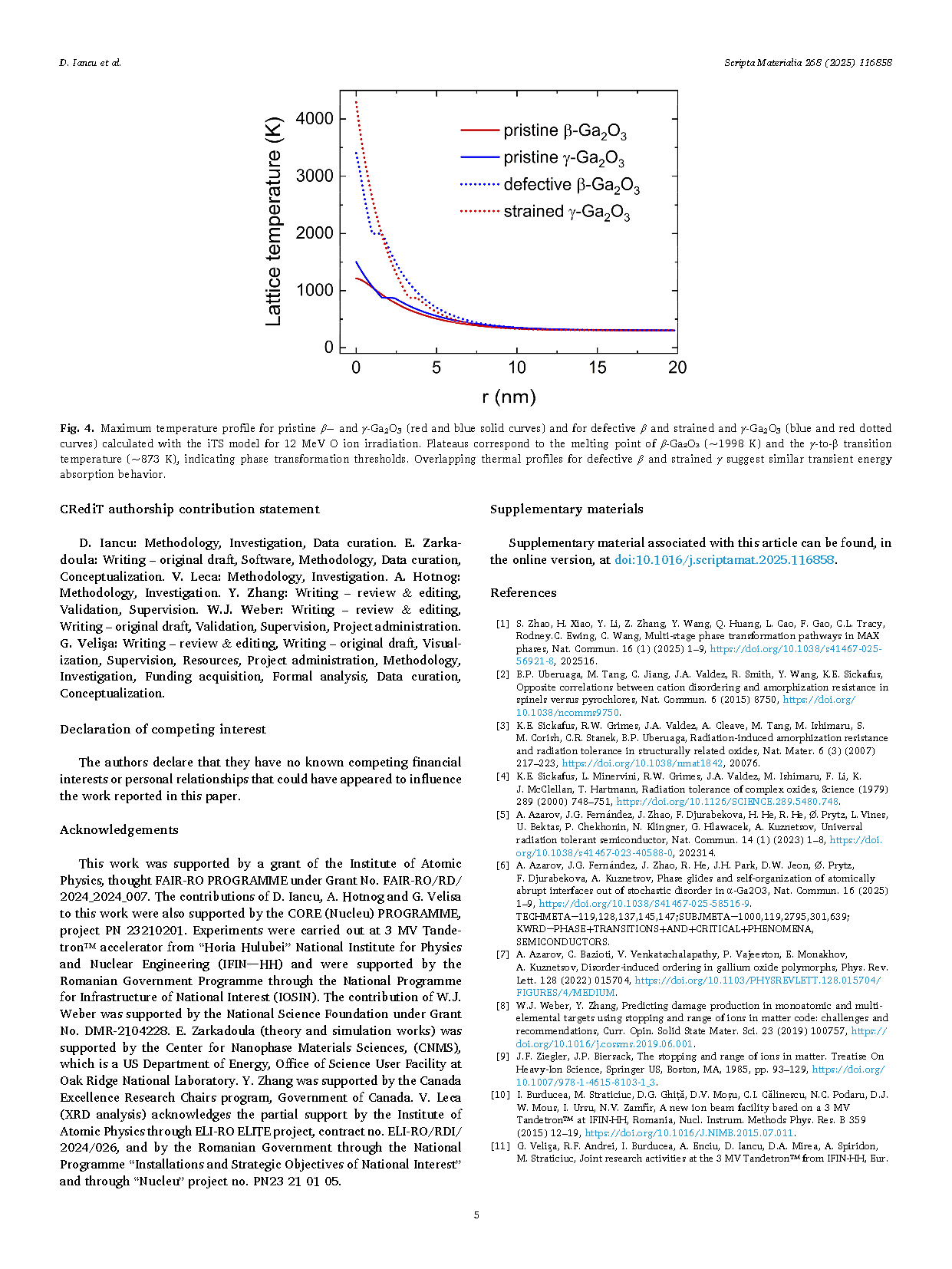
【International Papers】Intrinsic property of defective β-Ga₂O₃ to self-heal under ionizing irradiation
日期:2025-07-30阅读:125
Researchers from the Horia Hulubei National Institute for Physics and Nuclear Engineering have published a dissertation titled "Intrinsic property of defective β-Ga2O3 to self-heal under ionizing irradiation" in Scripta Materialia.
Background
Owing to multiple disorder-induced ordering pathways (polymorphic transformations), such as β-to-γ or α-to-γ , gallium oxide (Ga2O3) has emerged as a promising addition to the class of polymorphic materials. Studies on the evolution and stability of irradiation-induced structures (i.e., γ-Ga2O3) under subsequent heavy-ion irradiation have revealed that the γ-Ga2O3 maintains its long-range periodicity as ion fluence increases, contrary to the behavior typically reported for other polymorphic materials. Additionally, the thermal stability of such irradiation converted γ-Ga2O3 structures have been verified by means of isochronal annealing experiments. These studies revealed that the crystallinity of the γ-Ga2O3 structure improves with increasing temperature up to 1000 K; above this temperature, the γ-Ga2O3 structure starts to dissolve. On the other hand, little attention, if any, has been devoted to the response of the converted γ-Ga2O3 polymorph structure to subsequent highly ionizing irradiation (electronic energy deposition - Se).
Abstract
Damage evolution and phase stability in defective β-Ga2O3 and an irradiation-converted γ-Ga2O3 layer have been studied under ionizing irradiation at 300 K. By exploring athermal nonequilibrium processes in β-Ga2O3, we succeed in identifying a self-healing mechanism that enables defect recovery, characterized by a recovery cross-section of ∼0.17 nm2. Remarkably, this study further demonstrates that the crystallinity of the irradiation-converted γ-Ga2O3 layer improves under ionizing irradiation. More importantly, X-ray diffraction analysis reveals that the highly-strained γ -phase transforms into a highly-crystalline structure without film disintegration, contrasting to that reported for isochronal annealing at 1000 K. The inelastic thermal spike calculations provide insights into the important effects of energy transfer to electrons in reordering the local atomic arrangement of both defective β-Ga2O3 and γ-Ga2O3. This behavior suggests a pathway for low-temperature crystallization, offering a promising strategy for fabricating ultrahigh-speed non-volatile memory devices.
Conclusion
In summary, by exploring the interactions of highly ionizing irradiation with defective β-Ga2O3, and irradiation-induced γ-Ga₂O₃ at room-temperature, we reveal that ionization-driven athermal processes promote structural recovery in both phases. Notably, defective β-Ga₂O₃ exhibits self-healing under ionizing irradiation, with a σr of ∼0.17 nm². More specifically, the results show that the energy transfer of only 3.3 keV nm-1 from ions to electrons can recover the pre-existing defects (i.e., ∼60 % of the random or amorphous structure) and remarkably restore the pristine β-Ga2O3 crystal structure at 300 K. Importantly, the transfer of the same low Se value to electrons is also sufficient for converting the strained/defective γ-phase into a highly crystalline structure. The improvement of the crystallinity in this region is accompanied by a sharpening of the β/γ interface. Atomically sharp interfaces may enable the fabrication of ultrahigh-speed non-volatile memory devices. The iTS calculations provide insights into the important effects of energy transfer to electrons in the discovered self-healing mechanism. These results indicate that ionization-induced annealing can stabilize metastable polymorphic phases at low temperatures, offering new insights into the use of controlled irradiation to engineer defect states and phase stability in wide-bandgap semiconductors for advanced device applications.

Fig. 1. (a) Evolution of relative Ga disorder profiles in partially damaged (defective) β-Ga2O3 (f0 ∼ 0.6) upon sequential irradiation at 300 K with 12 MeV O ions at the indicated fluences. Also superimposed are Se curve across the pre-existing damage peak and the corresponding dpa profile for 0.3 Au+ nm-2 (see dashed and solid lines, respectively). (b) Normalized disorder recovery (N/N0) as a function of 12 MeV O fluence. The solid line recovery at the damage peak (N/N0).
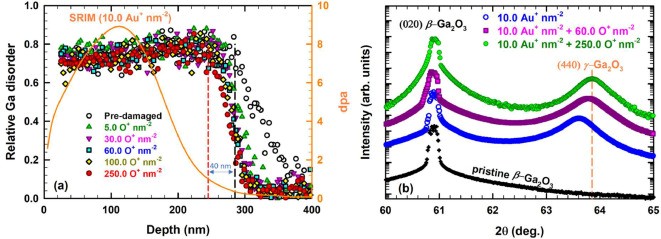
Fig. 2. (a) Relative Ga disorder profiles and (b) selected XRD θ−2θ experimental scans of γ/β -Ga2O3 bilayer prior to and following 12 MeV O ions irradiations at the indicated ion fluences in the legends.
DOI:
doi.org/10.1016/j.scriptamat.2025.116858
